"Nothing leads the scientist so astray as a premature truth." -Jean Rostand
One of the most awesome events, literally, that happens in this Universe is when stars -- giant nuclear furnaces like our Sun -- die in the most energetic way possible: a supernova.
Every star that ever lived gets two chances to end their lives in this most spectacular of fashions. The hottest, bluest, most massive stars that are born burn through their nuclear fuel incredibly rapidly, accumulating a core of heavy metals just one million years after they're first born.
When that core gets massive enough and nuclear fusion can no longer provide enough outward pressure to counteract the tremendous gravitational force trying to collapse the core, we get a supernova explosion! In the end, there's a degenerate neutron star or black hole where the core once was, and the outer layers get blown off in that supernova.
But what about the stars that don't get there? This is the vast majority of stars; they are the 99%, and so are we!
But the Universe is full of second chances for stars like ours. Because when we run out of our nuclear fuel, our Sun's core will contract down to a degenerate white dwarf, blowing off its outer layers gently (at least, gently compared to a supernova) in a planetary nebula. (Details here.)
The white dwarf that gets left behind -- this ultra-dense collection of atoms -- is comparable (in an order-of-magnitude way) in mass to our Sun, but comparable in physical size to the Earth.
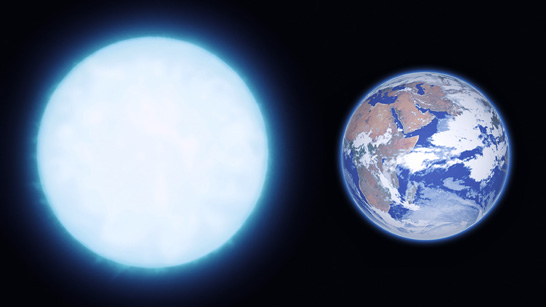
What's somewhat surprising about this white dwarf is that the more massive a white dwarf is, the smaller in size it gets! This is because the gravitational force is so great that it can compress the very orbits of electrons, making the atoms composing the white dwarf significantly smaller the more massive your white dwarf is.
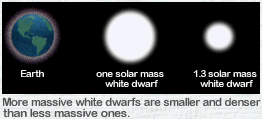
White dwarfs are very common in the Universe; in fact, if you want to find one, you need look no closer than the brightest star in the sky, easily visible from most places on Earth on clear nights.
The brightest star as seen from Earth is Sirius, a blue star located just 8.7 light years away. If you can find the constellation Orion and follow its belt, you should see a bright, twinkling star that rises in the East/Southeast portion of the sky around 9 PM at this time of year; that's Sirius. But Sirius isn't alone in its orbit; it's part of a binary star system! If you want to see its companion, though, you'll need something like the Hubble Space Telescope.
This white dwarf star, orbiting Sirius, is going to get a second chance at becoming a supernova! How's that?
Well, if you would have asked me just a few years ago, I would have told you the following story.
A white dwarf can siphon off mass from its binary companion, accreting that material on its surface, until a critical mass is reached. When a white dwarf has too much mass on it, its core can no longer withstand the immense gravitational force, and the atoms collapse, resulting in a runaway fusion reaction that destroys the white dwarf and -- you guessed it -- gives us a supernova!
But this is not the only possibility for creating a "second-chance" supernova; there is another.
Instead of siphoning mass off of a companion star, a degenerate white dwarf could merge or collide with another object -- like a second white dwarf -- and this could create a supernova explosion, too!
So which one is actually happening for these second chance (Type Ia) supernovae: the accretion, or the merger?
Here's the amazing thing: even though supernovae are rare, occurring only about once every 100 years in our galaxy, their remnants stick around for a long time -- thousands of years -- and we can watch them!
For instance, a supernova that went off in the year 1,006 not only has left X-rays behind, we can see the visible glow of its blown-off outer layers change over time!

Image credit: NASA, ESA, and L. Frattare (STScI); Hubble Heritage Team (STScI/AURA); and Winkler/CTIO/NOAO/AURA.
This supernova remnant is 5,000 light years, but we have an even cleaner, younger, more perfectly-symmetric supernova that went off in the Large Magellanic Cloud just 400 years ago! (From our perspective, obviously.) The Large Magellanic Cloud is a galaxy maybe 10% of the size of the Milky Way, and is located something like 170,000 light years away. As you can see from the bright pink color, it's full of young, star-forming regions.
With supernovae of both types (the large-mass, first-chance and the white dwarf, second chance types) occurring fairly frequently, we happened to be in the right spot to catch one particular supernova -- SNR 0509-67.5 -- have the light from its explosion bounce off of a cloud of nearby gas and reach our eyes, all while the actual supernova remnant itself is already visible!
But it's by actually looking inside the supernova remnant itself that we should be able to see whether this supernova came about by an accretion-followed-by-an-explosion or a merger-fueled-explosion. How's that?
As you can see by looking at the X-ray image (above), the Hubble optical image (below),
and the composite image of both overlayed atop one another,

this supernova remnant makes a near-perfect circle. If we head to the center of this circle, we should find the star it accreted matter from if that was how it formed!
But there is nothing at the center of this circle!
In fact, zooming in on the highest-resolution image available at the region where the leftover star should be, all we can find is a slightly cloudy region with a faintly-glowing red dot.

Now, if I had to guess, I would guess the same thing as Nancy over at Universe Today: it was probably another degenerate object that collided with the progenitor white dwarf, triggering this supernova.
But I want you to keep something else in mind: even with the Hubble Space Telescope, we can't see everything! Case in point: have a look at this gorgeous, rich, deep exposure of Hubble looking at a different region of the Large Magellanic Cloud.
I've gone into the highest resolution version of this image and pulled out the faintest, reddest, dimmest stars it can find. But at 170,000 light years away, even Hubble can't find everything.
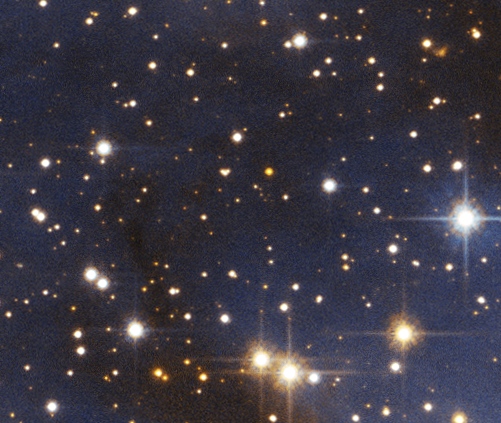
Behind the bright blue stars and the red giants/supergiants are faint stars, not unlike our own. But you know what's missing? The faintest ones, which also happen to be the most common stars known to us. It's just that they're so faint, only a few millionths the brightness of our Sun, that we can only see the ones less than 100 light years from us!
So this could have been a merger of two degenerate objects, but it could have also been a fainter, lower-mass star that fed a white dwarf, and we wouldn't be able to tell the difference. Enjoy all that we know about the Universe and feel free to place your bets, but don't bet the house until we've got some better evidence. Keep up with the latest supernova news, because this issue isn't settled yet!


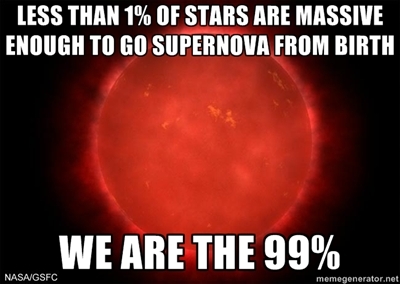

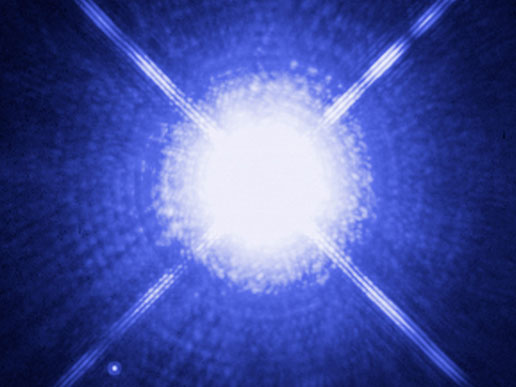

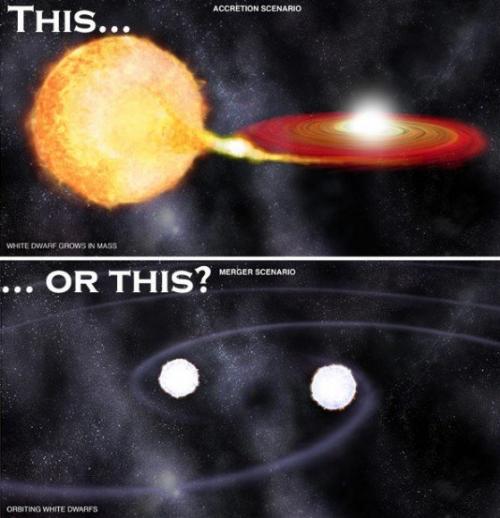




Who doesn't love explosions. Especially ones that leave entire stars in tiny pieces.
So, if 99% of stars end up as a dim dwarf we can't see, and the universe is old enough to have had 2 or 3 generations of stars, wouldn't this explain most of the dark matter?
So, the 99% are degenerate? At last, some science the Republican party can get behind!
Good post, of course (and can't you also get white dwarfs to go supernova by slowing down their rotation?).
Having just attended a lecture by Christian Ott at Caltech, he had some fabulous simulations trying to model stellar collapse and determine the precise mechanism leading to supernovae- a far more complex proposition than even merely its mass apparantly would dictate.
Here's the only public link I could find simulating the growing instability at the core:
http://www.tapir.caltech.edu/~cott/mov/collapse_v2.mpg
I thought that the "normal" SN I kind of explosion just completely destroy the white dwarf in the huge runaway nuclear process. So, while a SN II remnant may be a neutron star or a black hole, the remnant of a SN I is ... well, nothing but the outmost part which was expelled just before the explosion. Or at leat that is what I had been told :-))
So, finding nothing at the center of a SN I wouldn't demonstrate nohing, would it?
Thank you very much for these superb articles!
I wonder , what will happened to the earth after supernova? After reading this I can't wait for the latest supernova news.
I am enjoyed videos and photos...